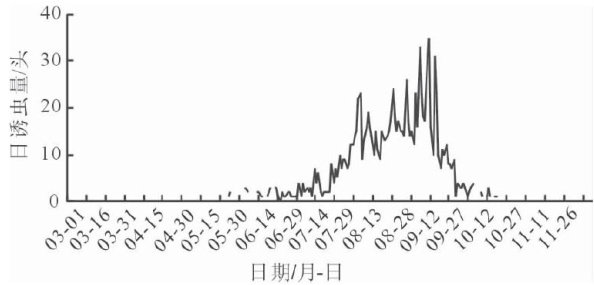天蛾科昆虫灯诱种群数量动态分析


打开文本图片集
中图分类号:S433.4 文献标识码:A 文章编号:0488-5368(2025)04-0089-06
Abstract:To understand the dominant population composition and dynamics of Sphingidae insects in Luohe, Henan province,the adult population in this area was systematically monitored using a light trap from 2014 to 2023.The results indicated that a total of 17 insect species belonging to four subfamilies,14 genus were captured using light traps in farmland.Among them,eight species belonged to Ambulicinae,including Clanis bilineata tsingtauica Mell,Marumba gaschkewitschii v Bremer et Grey,M. sperchius Menetres,Parum colligata Walker, Smerinthus planus Walker,Callambulyx tatarinovi Bremer et Gery,Oxyambulyx schauffel bergeri Bremer et Grey and o .ochracea Butler. three species were identified in each of the subfamilies of Acherontinae,Choerocampinae,and Philampelinae,namely Herse convoluli Linnaeus,Psilogramma menephron Cramer,Dolbina tancrei Staudinger,Theretra japonica Orza,T.clotho Drury,Pergesa elpenor lewisi Butler,Ampelophagarubiginosa Bremer et Grey,Macroglossum stelatarum Linnaeus and Acosmeryx castanea Rothschild et Jordan.The first and last occurrence days of the overallpopulation in Luohe were in mid-April and early November,respectively,with the trapping peak occurring from early July to early September. H. convoluuli,C. bilineata tsingtauica and T japonica were considered as dominant species,and their light-trapped regularityof the three were diffrent.The first and last occurrences of H . convoluuli were from middle May to early June and from late September to mid October respectively. The first and last occurrences of T :japonica were from middle April to late May and in September respectively,Compared with the other species, C . bilineata tsingtauica had a later first occurrence and earlier last occurrence,appearing from late May to mid June and from early and mid September,respectively. The peak period of light lure for H . convolvuli was from late July to early September,the peak period of light lure for T japonica was from late July to mid September,and that for C . bilineata tsingtauica was in mid and late July. Meanwhile,the peak occurrence date of C . bilineata tsingtauica was earlier and more concentrated than that of the other species.
Key Words: Herse convolvuli; Clanis bilineata tsingtauica;Theretra japonica; Monitoring light trap; Population dynamics ; Emergence peak
天蛾科(Sphingidae)隶属于鳞翅目(Lepidop-tera)蚕蛾总科(Bombycoidea),分布十分广泛,是生态系统中十分丰富的一类害虫[1]。(剩余5902字)